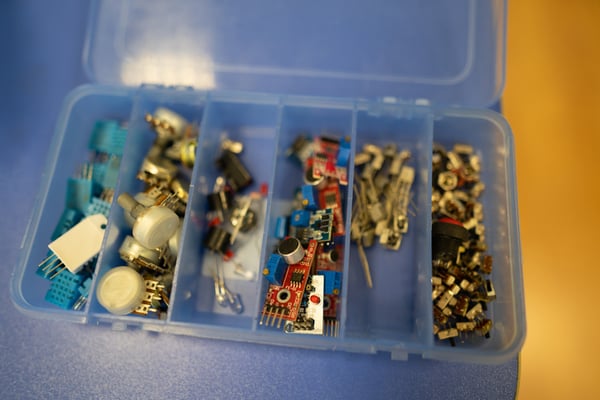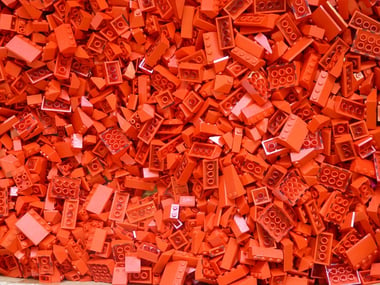Share this
Electronic Component Kitting: 4 Key Inventory Benefits vs. DIY
by Simcona on Oct 1, 2025 11:00:01 AM

If you have kids or remember being a kid, you can probably think of a time you cursed at a LEGO set. Small pieces were hard to find, multiple playsets got mixed in one Ziploc, and you nearly punctured your foot stepping on a stray block.
In the industrial electronics world, component kitting services ensure that a manufacturer's bill of materials comes to fruition easier than any LEGO set ever could. In capable hands, kitting can make the transition from sourcing to assembly as smooth as possible.
From streamlining workflow to cutting inventory costs, learn the four ways electronic component kitting services make you a leaner, meaner manufacturer. (We’ll also peek at the efficiency issues you’ll encounter if you try shortcuts.)
What Are Kitting Services?
In warehouse management, kitting is a fulfillment service that streamlines the ordering and storage of essential parts.
Historically, electronic components have been available in specific multiples and minimum quantities. For example, connectors may only be available in boxes of 25, with a minimum order quantity of 100 total connectors.
But what if you only need 35 this year for your current application? Or 110?
Electronic kitting companies bundle only the necessary volume for each of the project’s components. The distributor then merges the parts into a single order, assigning it an SKU.
“Kitting” does not necessarily equal “pre-assembly.” In most uses, the goal is simply to make assembly and inventory management much easier for the OEM. In essence, kitting is a one-stop distribution shop for all components necessary for a single application.
Benefits of Electronic Component Kitting
The #1 priority of industrial product manufacturing is to maintain smooth production flow, allowing you to focus on other aspects of your business. Here's how electronics kitting services help you do that:
- Cash flow
- Speed
- Floor space
- Easier transition from inventory to assembly
1. Cash Flow
The warehouse kitting process involves bundling all necessary parts, which you’d otherwise have to order in various minimums and multiples, into a single delivery.
Since electronic component kitting services offer more flexible order quantities, you can save money on:
- Unused inventory
- Shipping
- Labor (storing, picking, and taking inventory)
As you’ll see below, you’ll also cut costs through better data organization and faster turnaround.
 2. Speed of Fulfillment
2. Speed of Fulfillment
Even the world’s greatest LEGO builder will work far less speedily if his set isn’t organized in separate containers for each component. The same applies to electronic components.
Even for savvy facility operators, managing electronic component ordering is time-consuming. Whether your order is part of the products you sell or helps power the equipment that makes them, efficiency is critical to profitability.
With the help of component fulfillment services, businesses can eliminate guesswork and manual tasks from inventory management, thereby reducing the time gap between sourcing and manufacturing. When a crew goes to pick, pack, and assemble a kitted product, all the pieces are there in one place.
If your kitting and fulfillment provider also offers distribution expertise, you can trim even more time. Distributors with extensive supplier networks and inventory management capabilities can insulate you from downtime, enabling you to receive orders in days instead of weeks.
Instead of wasting time re-evaluating your stock every time you need more, opt for a more innovative warehouse solution.
3. Floor Space
Hundreds of small deliveries can quickly devour the floor space in your facility, especially if you’re juggling several product lines with separate inventories. The more inventory you cram into your facility, the easier it is to lose things. Adding warehouse space is an option, but a very expensive one.
The ability to receive kits without mandatory minimums and multiples eliminates bloat in the storage section of your facility. Similarly, bundling your needs on a product-by-product basis reduces inventory clutter.
When stock is visible and well-organized, logistics are easier to manage during seasonal changes and other shifts in production focus.
4. Easier Transition From Inventory to Assembly
Mistakes happen in sourcing and inventory – sometimes in mid-project, when you can least afford them. Kitting makes it easier to plan and execute a production schedule.
Imagine your company is building a piece of equipment that consists of 1,000 components. Some of the bigger ones are no big deal – someone pulls them off the shelf with no trouble.
But what if there are 20 different kinds of tiny capacitors? They might arrive in one big bucket, all mixed together. Or, you might have six different companies shipping orders of various capacitor types and quantities.
Being limited by order minimums and multiples means you don't always match production updates, forcing you to balance multiple numbers in your head. Having to manage the stock of 100s of parts from dozens of suppliers (and that's just for one project!) means there's a higher risk of error.
Electronic component kitting not only saves time when stocking and assembling, but also optimizes the process for efficiency. Kitting techniques reduce the pressure on the sourcing and material handling teams to be perfect.
The Cost of DIY vs. Outsourced Kitting
| Metric | In-House Kitting | Outsourced Kitting |
| Risk of Error | High -- multiple suppliers, manual processes | Low -- consolidated orders, professional oversight |
| Inventory Control | Inconsistent -- multiple stock points, difficult tracking | Streamlined -- single SKU, simplified management |
| Admin Workload | High -- sourcing, tracking, managing suppliers | Low -- one point of contact, simplified process |
| Storage Needs | High -- scattered parts, excess inventory | Minimal -- just what you need, bundled efficiently |
| Fulfillment Speed | Slower -- longer lead times, manual handling | Faster -- ready-to-go kits reduce turnaround time |
Alternatives: Insourcing Kitting & Direct Component Buys
Outsourcing component kitting and general fulfillment is almost always the best approach for industrial electronics. However, some OEMs do opt to kit orders in-house or buy directly from part manufacturers.
Here’s how in-house sourcing and kitting without a distributor tends to go in less-experienced hands:
- When the OEM doesn’t have enough stock to complete a job, its purchasing department sources the missing components.
- The process halts because the purchasing cadence and current market supply aren’t in sync …
- … Or because each of the project’s 700 component types had varying levels of stock remaining, and someone got confused or miscounted.
- Eventually, the products arrive, and a crew unloads and stores the parts.
- Someone writes a component pick list for the production line.
- An operator builds a kit based on the pick list. This includes counting the parts, scanning for lot control, and placing the parts on a kitting trolley … many times over.
DIY electronics procurement and kitting in warehouse environments sucks resources from your operation while tacking on:
- Administrative overhead
- Floor space consumption
- Additional inventory management
And that list doesn’t even account for the electronic component supply chain shortages and other challenges that come with trying to skip the middleman.
The other option is to continue sourcing in a traditional manner.
This means paying for and managing whatever multiples and minimums of stock the manufacturer is willing to offer. You’ll have to be extra careful about inventory levels, because non-kitted parts run out at different times. If just one component runs out, your production schedule is shot.
You’ll also have less backup when it comes to tracking availability, managing lead times, and monitoring supply chain issues.
Kitting Components With the Supply Chain in Mind
The increasing complexity of project manufacturing is putting owners and facilities through the ringer. Electronic component kitting is a high-value service that eases supply chain pain and helps manage:
- Your projects
- Your inventory
- Your budget
- Your time
You’d be surprised how many component supply chain issues disappear by pairing kitting practices with a full-service distributor (which is why we discourage DIY approaches). Outsourcing to the right kitting center or full-service distributor equips you with dedicated experts who can do it better than you could alone.
While vetting potential partners, consider your broader distribution needs. Some companies specialize in kitting/warehousing/fulfillment, while others bundle those services into a turnkey electronics distribution solution.
Ready to Streamline Your Sourcing Strategy?
Talk to a kitting expert and take the next step toward a more straightforward, faster, and more cost-effective fulfillment process.
Share this
- Components (39)
- Cost (29)
- Distribution (21)
- Materials (21)
- Cables & Wires (20)
- Supply Chain (19)
- Standards & Certifications (18)
- UL (17)
- Control Panels (16)
- Safety (14)
- Design (13)
- Contract Manufacturing (11)
- Inventory Management (11)
- News (10)
- Jacketing & Insulation (9)
- Suppliers (8)
- Wiring (8)
- Availability (7)
- Design & Engineering (7)
- Obsolescence Management (7)
- Testing & Prototyping (7)
- Maintenance & Downtime (6)
- Temperature & Fire Resistance (6)
- Enclosures (5)
- Manufacturing (5)
- Circuit Protection (4)
- Data Centers (4)
- Kitting & Fulfillment (4)
- Labeling (4)
- Sensors (4)
- Corrosion (3)
- Datacom (3)
- Cooling & Fans (2)
- Supplier Spotlight (2)
- Automation (1)
- Honeywell (1)
- PLCs (1)
- Relays (1)
- Security (1)
- November 2025 (1)
- October 2025 (1)
- August 2025 (1)
- July 2025 (6)
- June 2025 (4)
- May 2025 (4)
- April 2025 (3)
- March 2025 (11)
- February 2025 (3)
- January 2025 (2)
- December 2024 (1)
- November 2024 (1)
- October 2024 (1)
- September 2024 (3)
- August 2024 (1)
- July 2024 (4)
- June 2024 (3)
- April 2024 (2)
- March 2024 (1)
- January 2024 (1)
- October 2023 (1)
- June 2023 (1)
- May 2023 (1)
- April 2023 (1)
- March 2023 (2)
- October 2022 (1)
- March 2021 (3)



No Comments Yet
Let us know what you think